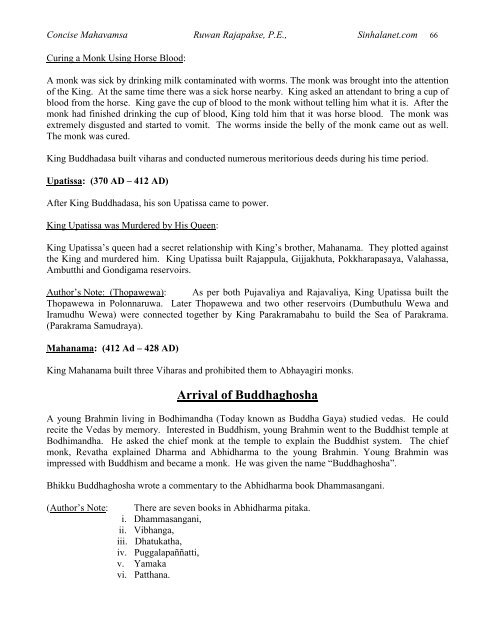Concise Mahavamsa Ruwan Rajapakse, P.E., Sinhalanet.com 1
Concise Mahavamsa Ruwan Rajapakse, P.E., Sinhalanet.com 1
Concise Mahavamsa Ruwan Rajapakse, P.E., Sinhalanet.com 1
Create successful ePaper yourself
Turn your PDF publications into a flip-book with our unique Google optimized e-Paper software.
<strong>Concise</strong> <strong>Mahavamsa</strong> <strong>Ruwan</strong> <strong>Rajapakse</strong>, P.E., <strong>Sinhalanet</strong>.<strong>com</strong> 66<br />
Curing a Monk Using Horse Blood:<br />
A monk was sick by drinking milk contaminated with worms. The monk was brought into the attention<br />
of the King. At the same time there was a sick horse nearby. King asked an attendant to bring a cup of<br />
blood from the horse. King gave the cup of blood to the monk without telling him what it is. After the<br />
monk had finished drinking the cup of blood, King told him that it was horse blood. The monk was<br />
extremely disgusted and started to vomit. The worms inside the belly of the monk came out as well.<br />
The monk was cured.<br />
King Buddhadasa built viharas and conducted numerous meritorious deeds during his time period.<br />
Upatissa: (370 AD – 412 AD)<br />
After King Buddhadasa, his son Upatissa came to power.<br />
King Upatissa was Murdered by His Queen:<br />
King Upatissa’s queen had a secret relationship with King’s brother, Mahanama. They plotted against<br />
the King and murdered him. King Upatissa built Rajappula, Gijjakhuta, Pokkharapasaya, Valahassa,<br />
Ambutthi and Gondigama reservoirs.<br />
Author’s Note: (Thopawewa): As per both Pujavaliya and Rajavaliya, King Upatissa built the<br />
Thopawewa in Polonnaruwa. Later Thopawewa and two other reservoirs (Dumbuthulu Wewa and<br />
Iramudhu Wewa) were connected together by King Parakramabahu to build the Sea of Parakrama.<br />
(Parakrama Samudraya).<br />
Mahanama: (412 Ad – 428 AD)<br />
King Mahanama built three Viharas and prohibited them to Abhayagiri monks.<br />
Arrival of Buddhaghosha<br />
A young Brahmin living in Bodhimandha (Today known as Buddha Gaya) studied vedas. He could<br />
recite the Vedas by memory. Interested in Buddhism, young Brahmin went to the Buddhist temple at<br />
Bodhimandha. He asked the chief monk at the temple to explain the Buddhist system. The chief<br />
monk, Revatha explained Dharma and Abhidharma to the young Brahmin. Young Brahmin was<br />
impressed with Buddhism and became a monk. He was given the name “Buddhaghosha”.<br />
Bhikku Buddhaghosha wrote a <strong>com</strong>mentary to the Abhidharma book Dhammasangani.<br />
(Author’s Note: There are seven books in Abhidharma pitaka.<br />
i. Dhammasangani,<br />
ii. Vibhanga,<br />
iii. Dhatukatha,<br />
iv. Puggalapaññatti,<br />
v. Yamaka<br />
vi. Patthana.


